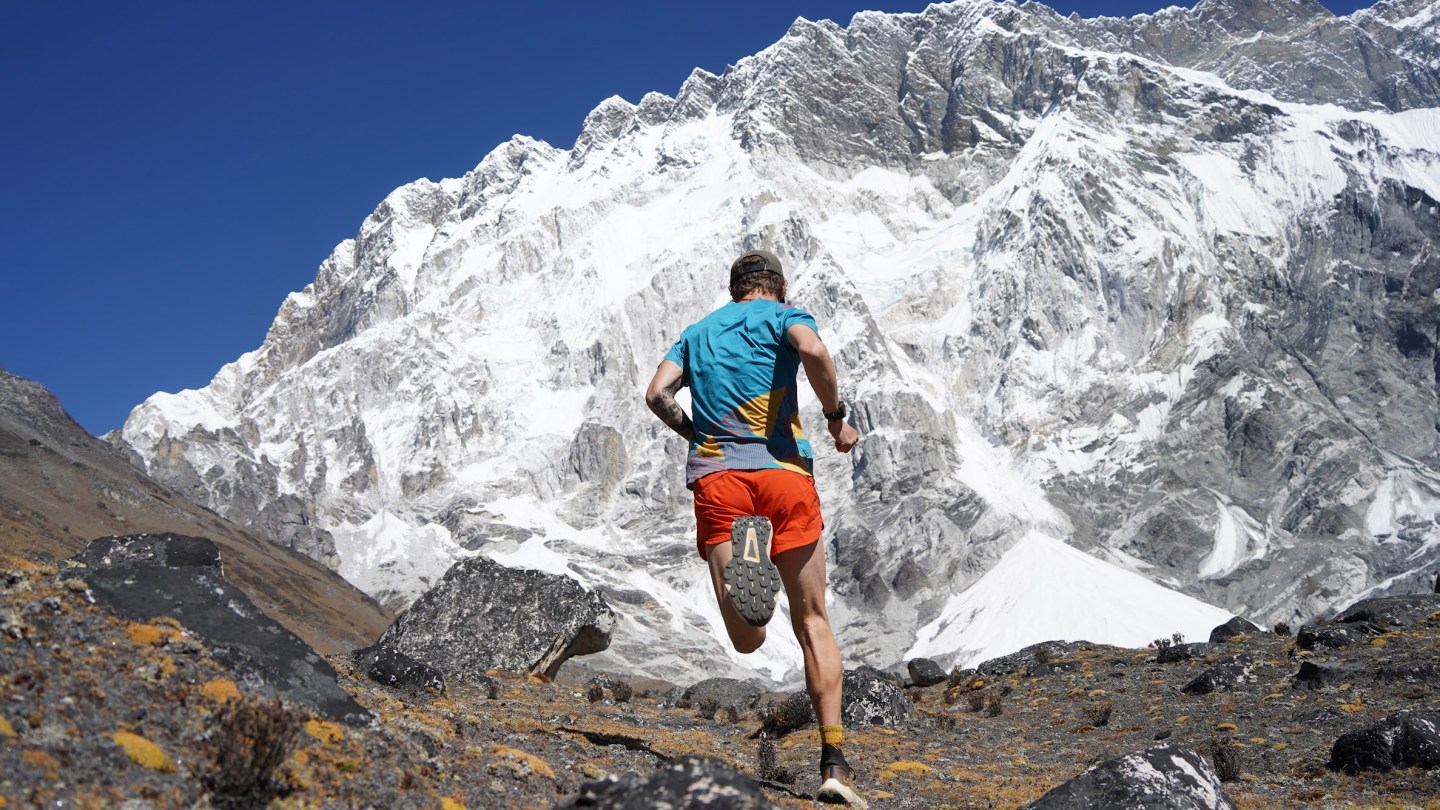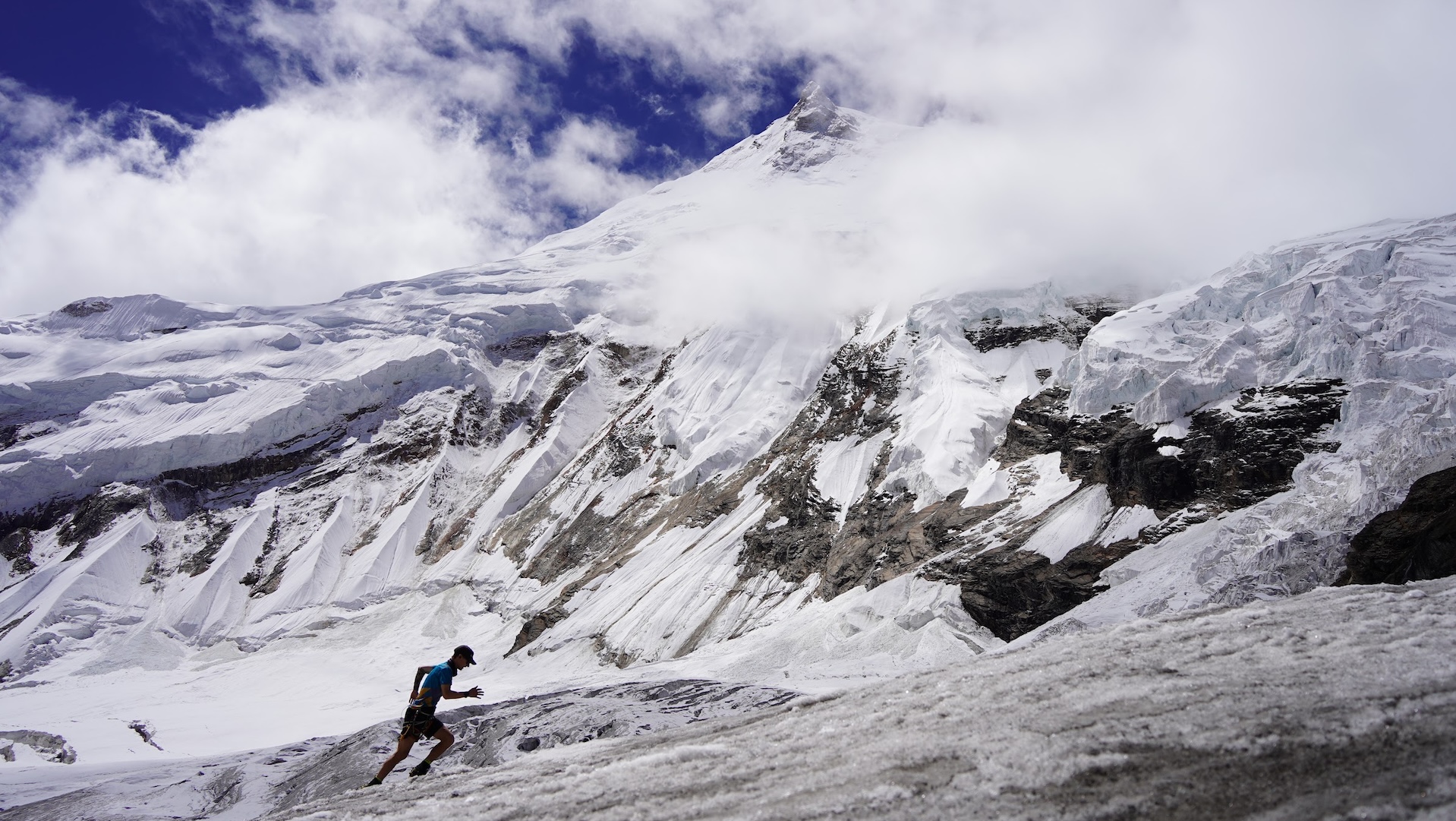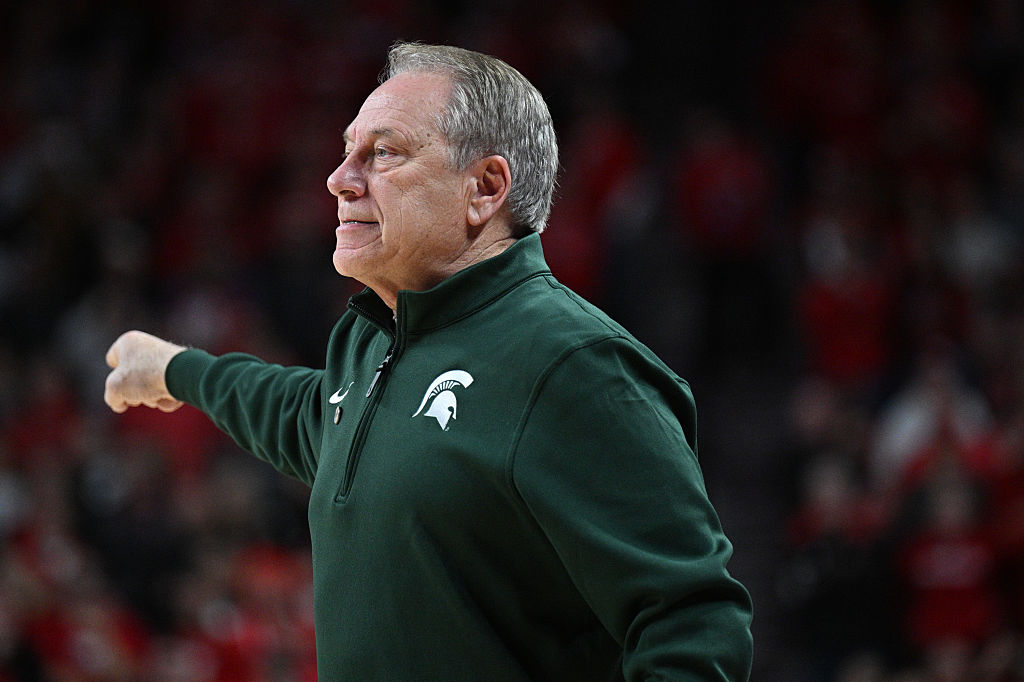In 2019, while in Peru as a camp counselor, Tyler Andrews set his first Fastest Known Time (FKT) on the 37.9-mile Salkantay Inca Trail, which leads to the summit of Machu Picchu. Andrews’s time beat the previous mark by more than two hours. He identified primarily as a distance runner back then—he’d earned a spot at the U.S. Olympic trials for the marathon in 2016, would do so again in 2020, and had a personal best of 2:15:52—but his performance on the Salkantay Inca Trail kickstarted a new athletic career as a full-fledged mountaineer ascending the tallest mountains in the world in pursuit of various speed records. In May, he aimed to set one on the loftiest setting of all: Mount Everest.
Andrews exploded into elite-level running from inauspicious beginnings. He was a music and theater head in his younger years and didn’t crack 18 minutes in the 5K in high school. But he was fiercely hardworking, discovered he had an enormous VO2 max, and improved steadily all the way into the professional ranks. Like with his running career, once Andrews started making inroads into the mountaineering world and claiming FKTs, he didn’t stop. Since the Salkantay speed record, Andrews posted several new FKTs each year, setting new standards on Mount Fuji, Kilimanjaro, and the towering, 26,781-foot monster Manaslu, among many others.
For Everest, Andrews trained rigorously in pursuit of base-camp-to-summit and base-camp-to-summit-to-base-camp records set without the help of supplemental oxygen. He brought an exercise bike and a hypoxic generator to Khare, Nepal, with which he simulated conditions even higher than Everest’s dizzying summit. In the runup to his FKT bid, Andrews wrote recaps of his training logs, podcasted with his father, coached athletes remotely, and grinded away on the bike.
Despite whipping himself into fearsome shape, Andrews was undone by bad luck on the mountain. During his first attempt, on a furious pace well ahead of record time, Andrews exchanged his spiked running shoes for climbing boots at Camp Three. While yanking them on, the zipper on one of the boots cracked in two, rendering the boot an insufficient barrier from frostbite. Andrews tried to continue up with a bag wrapped around the boot, but moisture seeped through regardless and he turned back rather than risk his toes.
On his second attempt, carnivorous winds demanded the grudging use of supplemental oxygen so as to hang onto his extremities, then a turnaround high on the mountain. Andrews retreated to Kathmandu afterward, assuming the season was over. But a promising weather forecast and a team of Indian Army climbers remaining on the mountain left the door open for one final summit bid. Returning to the mountain at the 11th hour, he finally made an attempt limited by his own energy reserves rather than external factors, but just above Camp Four, he reflexively vomited up an energy gel, and a lack of fuel eventually forced another turnaround, this time in the shadow of the summit.
Full disclosure: I met Andrews as a camper in Peru, where he was one of my counselors. The Salkantay trail that Andrews completed in barely over six hours took the other mortals and I four days to walk. Afterward, he trained me remotely for a little while until I jacked up my foot in 2020. About three weeks clear of his third attempt on Everest, Andrews chatted with me over a Zoom from his home in Quito, Ecuador about his career arc, what it feels like near the top of Everest, and his lingering emotions from his time there. The interview has been edited and condensed for clarity and length.
If it’s all right with you, I want to start by reading you a line from a blog after you got your first FKT.
OK.
“The trail world is such a wide and varied one. I’m still such a novice that I think there’s a pretty steep learning curve for me to really be competitive. We’ll see.” So I guess my first question is, what’s happened since then?
Oh, gosh! When was that? Was that from Salkantay? Seems like a lifetime ago. [laughs] Yeah, a lot has happened. I think there’s still a lot of truth in that. The more you get into it, the more you realize how broad it is and how competitive the very top players are.
I was actually just talking to someone about how these seemingly unpredictable and random strings of coincidences sometimes lead us to these really big, important things in our lives. For me, COVID, the silver lining was that it really did open me up to the world of FKTs and mountains and trail running much more. There were no trail races or road races for a solid 6-12 months. I just kind of ended up in the FKT world by default because my then-sponsor was like, “Hey, we’ll pay you guys a bonus as if you do some of these FKTs during COVID.” So that was really the thing that forced my hand a little bit to go and try some of this stuff. It was actually here in Ecuador, the first legitimate mountain FKT I went for, which was Cotopaxi. That went really, really well, and from there it all lily-padded to the next thing. It was this process of going to bigger and harder mountains, and longer routes. I definitely feel like I’ve made some progress, but I still feel like there’s a lot of room for improvement.

As you’ve started to get deeper into it, how much do you find that setting FKTs on mountains aligns or differs from distance running?
I think that it really depends on the mountain. I’ve leaned into the mountains that are less technical and do lend themselves better to the running background. Moving uphill quickly, you need a lot of the physiological skills and skillset that you would want for being a really good ultra runner or even marathon runner, in the sense that it’s just a really hard aerobic task. Even a mountain like Everest is so big and complicated, but at the end of the day, you’re basically just moving uphill. There’s nothing tremendously technically difficult about Everest.
Going into that, what was your level of expectation, but also kind of primal fear with a place that legendary?
I think the biggest challenge of Everest is the altitude. It’s just really, really high. Your body is really not good at dealing with life at 20,000 feet, let alone 29,000 feet. There aren’t very many mountains over 8,000 meters. I’ve probably been over 8,000 meters four or five times in my whole life before this season. I think if you’d taken me from 2019 and thrown me at Everest that year, I would’ve been so far out of my depth and it would have felt really scary and intimidating.
I think a lot of climbers hear, “Oh, it’s so easy, yellow brick road, walk your way up the mountain.” I think if you have a little bit of experience, that is kind of true, especially climbing with a lot of supplemental oxygen, which is how most people get to the summit. But if you’ve never put crampons on, and you’ve never climbed on a glacier, and you’ve never clipped into a rope before, and you’ve never rappelled—those are things that I’ve done quite a bit of over the last five years, very intentionally, to develop those skills and become more comfortable so those things become second nature and feel very safe to me. Whereas someone who might never have done that before, OK, that’s gonna feel really different.
Manaslu, which is I think the sixth or seventh-highest mountain in the world, which is where I set a record last fall—and that was kind of my proof of concept for Everest—it’s a big mountain, but it’s also 650 meters short of Everest. That’s a lot. Every step you take gets exponentially harder once you get above that altitude. It’s like you get to the summit of that mountain, and then you have the hardest part to go.
If you’re asking about actual fear or danger on the mountain, for me, it’s always about the things you have no control over. Things like avalanches and Icefall serac collapse. Those are the things that keep me up at night a little bit. But at the end of the day, if you’re gonna go into the mountains, you’re just accepting that there are certain risks that are totally outside your control, and you just have to be OK with that.
That’s a good transition into your Everest attempts themselves. It seemed like almost all of the stuff that went wrong was kind of out of your control. Is that liberating in a way, because then you can’t really blame yourself, or is it more frustrating?
Oh, no. It’s much more frustrating. If it’s something where I messed up or I’m just not fit enough, then that’s easier to accept. But if it’s my boots that broke on the very first try, on May 11, it’s just like, God, if that hadn’t happened, it probably goes that day, and the whole season is over and the whole project is over. That one piece of metal literally derails the entire project. For me, that is so much more frustrating. [laughs] Maybe because I’m a control freak. I would rather take responsibility for it. At least then I know what I can fix for next time. You can get as fit as you want, it doesn’t matter, because there’s always stuff outside your control.
For me, that was by far the biggest takeaway from this year: It’s a tremendously complex project. The fitness is almost the easy part. That’s the part you can control. I know I can get fit enough to do it, but then you have to get all these other things to line up on the day you’re trying to do it. That’s the part, to me, that’s really, really hard. And that’s probably why no one’s set the record for, like, 40 years. [laughs]
In terms of the mountain itself, when you were climbing, how did it differ or prove similar to the representations of Everest in popular culture?
That’s a good question. I’ll turn it back to you—what is your impression of Everest, consuming it from a popular culture side?
Definitely overcrowded by perhaps underqualified tourists, I would say. The yellow brick road line is something I’ve read before. Not technically super challenging, but extremely dangerous. Summit fever is a big thing that I’ve read about, where people can make the summit but absolutely gas themselves to do it and die on the descent.
That’s a pretty good representation, I’d say. The overcrowding is an interesting one because it’s all relative. The photos that kind of go viral every year, where you’ll see this line of, like, 300 people in space suits just standing there—that is true. But it usually only happens one or two days a season. A lot of people’s first question to me is, “How do you deal with these lines of 300 people?” Well, we’re gonna be sitting in Base Camp that day, because obviously, you can’t get around all those people. But I think it’s overblown in the sense that I think some social media or news outlets will present it as This is a normal day on Everest. I made three different attempts, where I got above Camp Four, the final part of the mountain. On all three of those attempts, I don’t think I ever had to wait for anyone. I never had to wait in line. So it’s partly about timing and selection of the day that you’re going.
There are some really outrageous luxury items that you see—people with $10,000 coffee espresso-makers and shit. That part is real. But in terms of, oh my gosh, you can’t enjoy it, or you can’t have a beautiful connection with the mountain up there, I think that’s not true if you are a little bit flexible with when you climb, and you’re not climbing with a humongous group of people. I have many beautiful, special moments that felt like, I’m just alone on the mountain.
This year, I think there were five fatalities on the mountain on both sides. That’s compared to, I think, 18 from the year before, so it’s a much lower number. It’s still five human beings who died, which is obviously a tragedy for them and their families, but it’s a thousand people hanging out for a month-plus in a very, very inhospitable place, doing something that’s kind of dangerous. At the end of the day, I think you’re gonna have stuff like that that happens, whether you have really inexperienced climbers or professional climbers.
Could you tell me about one of those moments where it felt like it was just you in nature?
The last attempt that I made, on May 26/27, it was super last-minute, all came together, and there was this moment of getting through the Khumbu Icefall, which is to me the most dangerous part of the mountain—this big jumble of blocks of ice that are moving down the glacier a meter or so a day, and you’re walking through these things. It’s really scary, and really not that cool, and this is one of these objective hazard things where it’s so outside of your control because any one of those things could just tumble at any minute.
I remember going through there by myself and getting to the top of the Khumbu Icefall, where it flattens out. I’m in this section called the Valley of Silence. I think it was almost a new moon. Stars were super bright. I’m the only person there, because so many people had already left the mountain at that point. Being there in the dark, and all the stars above—OK, there’s maybe one headlamp a thousand meters above me, but otherwise it just felt like I was in the middle of outer space. That was pretty special, and pretty wild given that it has a reputation of being so crowded.
And the other one I’ll say, when I turned around, when I was really high on the mountain, I was literally the last person high on the mountain, of the entire season. Because this was the last climbing day. I remember there was a woman who was also climbing without oxygen, and she was coming down as I was still going up at, I don’t know, 8,300 meters. I realized once I had passed her, there was no one above me. I wasn’t on the summit of the mountain, but I was the highest person on earth with two feet on the ground. With every step I took, I was getting farther and farther away from civilization. And no one was behind me coming up. I was the only person on that part of the mountain, and I had it entirely to myself.

What are the actual physical sensations of being that high above sea level?
We had this hypoxic generator with us in Nepal that we were using to train. I’d been using this thing for four months at this point leading up to it, and very gradually been building my tolerance for hypoxia and high altitude. I was using the bicycle and started at 6,000 meters in January, and by the end of the season, I was biking at cruising altitude of a 747—35,000 feet, or something. These people who were decently well acclimated to 5,000 meters put this mask on after I’d gotten off the bike at 11,000 meters affected altitude or something, and within 45 seconds, were about to pass out.
Walking up Everest from Camp Four to summit is not physically challenging from a muscular perspective. It’s like two miles, and it takes, like, eight hours. You’re just walking up a hill very, very slowly. The challenge is doing it in an incredibly hypoxic state that feels really bad even if you’re pretty well acclimated. The way that manifests for me is mostly this sensation of really, really wanting to stop and turn around. That is such a strong, almost visceral, instinctual, animal feeling of This feels really bad, and I know it’s gonna get even worse as I go up, and yet I’m still going up, and that feels like a really bad idea. That’s my subconscious thought every step.
That little voice in your head is so hard to quiet. I think that if you’re already aerobically fit, most of the challenge of climbing a really big mountain like that high up is a battle with your own brain. It’s mostly convincing your brain that this is OK, when really it’s not that OK and you just need to keep going. Even if it’s something so unbelievably important to you and you’ve put so much work in, like this project, you still have this voice in your head that’s like, N-n-n-n-no, you don’t understand, you need to go down right now. This is really bad. Life is not meant to exist up here, and we should not be here. That is the most profound sensation that I feel and have to deal with up there.
How do you keep going through that?
I say a lot that one of my greatest skills as an athlete is my ability for self-deception. It’s just lying to that little voice in my head. Saying, You know what, OK, I’m just gonna take 20 more steps up the mountain and then we’ll pause for a minute, and it’ll feel better. It’s breaking it up into chunks that the brain can handle. It’s this idea that your brain is projecting out how things are gonna go and how things are gonna feel. Oh, no, things are gonna get harder, or things are gonna feel even worse than it feels now and I already don’t feel that good, and so there’s no way I can do that.
The way to combat that is by saying, OK, I’m not gonna think that far out. I’m only gonna think about the immediate present and maybe the next handful of seconds or steps that I can actually imagine getting through, or tolerating. And then doing that, and using that as fuel for the next five minutes or five steps. That’s kind of always been my strategy with endurance sport, just trying never to think about the whole thing that you’re doing because it’s way too much to grasp and to deal with mentally. Whereas if you have everything broken up into sections, when it starts to get really hard, those sections become smaller and smaller, and you kind of live in these really tiny spaces.
Now that you’ve gotten some distance from Everest, what are your lingering thoughts about the three attempts themselves?
The big takeaway is that having the opportunity to go back and do the last go-round completely changed how I view the season. Either way, I was going to be disappointed leaving without the record. After the second attempt, and even after the first attempt with the boot issue, I got turned around by my team because of things that were outside my control. The first time it was the boot, the second time it was just way too windy up high, so our safety team said, “No one’s going to the summit today, turn around.” If that had been it, I would have been unbelievably disappointed, because I would have felt like I didn’t really get to push myself that hard from a fitness perspective.
The third time was the one time when everything on the mountain went perfectly. The weather was great, my gear worked well, the route was in good condition. It was really just [that] I was exhausted. Knowing that I turned myself around, it’s disappointing, but I had that control, and I knew I left it all out there. If I had gotten down after that third attempt and again, I went back to Kathmandu, and they were like, “Hey, there’s one more window on the 29th!” I would have been like, “Nope, I’m done. I’m going home.” That was probably the most tired I’ve been in my entire life, after I got down from that final attempt. OK, wasn’t good enough this year, and I need to go home and recover and go back to the drawing board and start doing some postmortem and problem solving and thinking about what I can do better.
Is there any part of you that doesn’t want to go back?
Oh, yeah. Even on May 11, I was like, OK, this is the last time I’m ever gonna have to go through the Khumbu Icefall. And then I went through two more times the next two weeks! Coming off the mountain, oh, man. It’s hard to think that far ahead. You’re so close to the event, and it’s so hard, and it’s scary. So much prep goes into it, and it feels impossible. It’s been three weeks since I was on the mountain, and even now, it still feels a little bit raw. Imagining all the work I put in this winter and spring to get ready, and then all the work we put in on the mountain, the idea of doing that again is really intimidating.
But at the end of the day, it’s a project that I know is within my capabilities. And that, to me, is almost the most intoxicating goal, where it’s like, OK, I know I can do it, but it’s still gonna be really hard and take a lot of work and some stuff has to fall your way. To me, it’s the gambler’s fallacy, the intermittent reward where it’s not guaranteed, that makes it most exciting to me. For most people, one trip up Mount Everest in their lifetime is a literal lifetime achievement, and I made three in the last month. And I’m gonna go back again. Yes, it’s scary, it’s hard, and all this, but I’ll get my head there eventually. It’s a project that’s important to me enough and within my capability that I know it’s something I want to do when I zoom out and get out of my own head.
What do you wish I had asked you about your time there?
[laughs] That’s a good question. It does take a village to pull off a project like this. We have an incredible team behind me. My climbing partner, Chris Fisher, and Dawa Steven Sherpa, our on-the-ground logistics guy and Base Camp manager. Doctor Ben, who’s our physician in Base Camp. We have so many incredible people. I absolutely would not be up there doing what I do without a lot of people who I really, really trust, who are really, really good at what they do in my corner behind me, helping me. Along with decision-making and logistics, and all these important things. That’s a really important thing to highlight.






